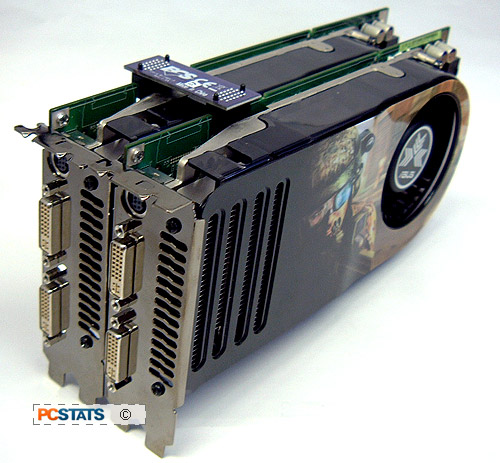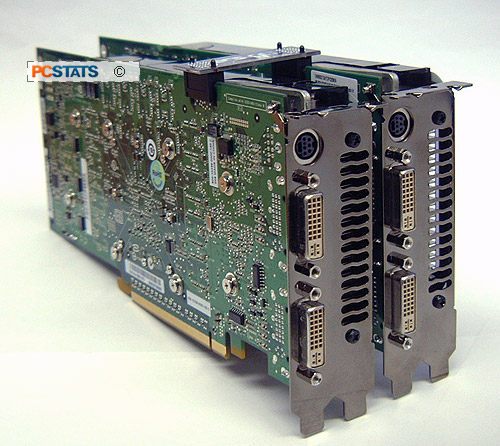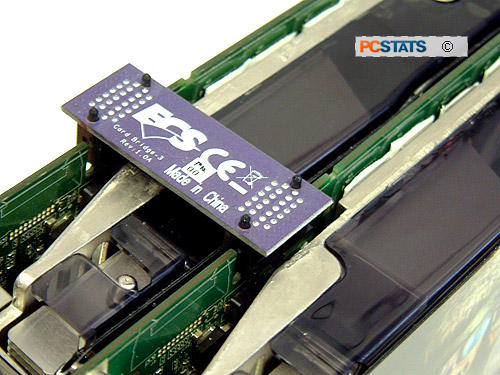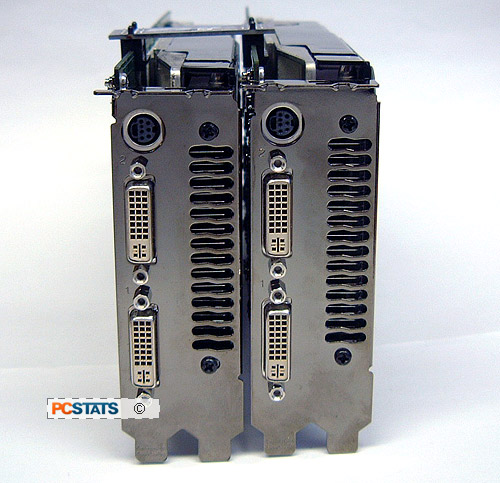Alright, let's say you've got $600 US to spend on a
kick ass videocard... or videocards. :-) What are you going to get!?
The nVIDIA GeForce 8800GTX is the undisputed king of graphics cards right now, but on the next notch down the GeForce 8800GTS 320MB offers a heck of a lot of value and that's hard to pass up. Doing the math, for the price of one super high end PCI Express videocard, you could have two 8800GTSs running in SLI! This is definitely an enticing option, but which route really is the faster choice?
In the past the question would have been an easy one to answer; go with the single faster videocard. Now a days, SLI has gained a lot of support from game developers and so the answer is not as clear. At lower resolutions a GeForce 8800GTX videocard would probably be faster due to its higher clock speeds, both core and memory, but in practical terms who buys a high end card to play at 1024x768?
In this review PCSTATS will lay down the benchmarks and fiddle with the
resolutions so you know for certain what choice, dual Geforce 8800GTS-340's or a
single Geforce 8800GTX videocard offers the best bang for your buck. When it
comes to high resolutions, that is where gaming is headed.
 |
|
nVidia Geforce
8800GTS-340 in SLI Videocard |
|
|

| | |
Will two GeForce 8800GTS 320MB videocards outperform a single GeForce 8800GTX? That is the question.
Before we get started let's first meet the contestants.
The tag team consists of the MSI
NX8800GTS-T2D320E-HD-OC and Foxconn FV-N88SMCD2-ONOC. Bot graphics cards rely upon
the GeForce 8800GTS 320MB GPU, and both are overclocked slightly from the
factory. When running in SLI, both cards will be operating at 575 MHz core and
1700 MHz memory. The MSI NX8800GTX-T2D768E-HD will represent the GeForce 8800GTX in all its mind blowing great framerate pushing goodness.
All GeForce 8800 series videocards use the nVidia G80 core, so technologically speaking, the differences between the GeForce 8800GTX and 8800GTS are quite subtle. There are two main differences between the two high end GPUs thought; the 8800GTX uses 128 Stream Processors while the 8800GTS has just 96 Stream processors.

The memory controller on the 8800GTX is 384 bits wide,
but the 8800GTS memory bus width is only 320 bits wide. In other words, clock
for clock the GeForce 8800GTS processes slower than the 8800GTX, at least on paper.
The current generation of DirectX 9 games do not require a lot of videocard memory, but everyone is expecting DirectX 10 games to chomp through memory like no tomorrow. Of the DirectX 10 videocards that are available, all pack in the videocard memory. It's a sign of things to come.

The GeForce 8800GTX has 768MB of onboard memory, while the GeForce 8800GTS
comes in two flavors, 640MB and 320MB. Only when DirectX 10 benchmarks are available
will we really know if the extra memory is really required. At the moment all
that memory does little for DirectX 9 titles.
Alright let's get to the testing! Up next PCSTATS will be
pitting the videocards against one another in a battle of titanic proportions. Place your bets, will dual Geforce 8800GTS videocards stack up under SLI against a lone Geforce 8800GTX?

Prelude to Benchmarks
The details of how the videocard test system was
configured for benchmarking; the specific hardware, software drivers, operating
system and benchmark versions are indicated below. In the second column are the
general specs for the reference platforms these nVIDIA GeForce 8800GTS 320MB
based videocards in SLI are to be compared against. Please take a
moment to look over PCSTATS test system configurations before moving on to the
individual benchmark results on the next page.
 |
| PCSTATS Test System Configurations |
|
|

